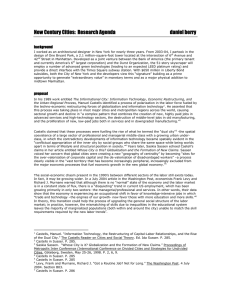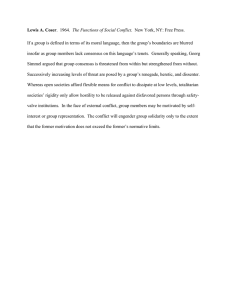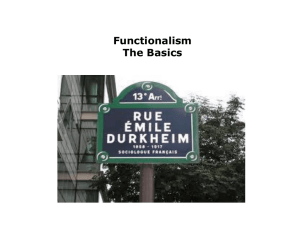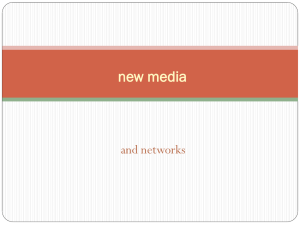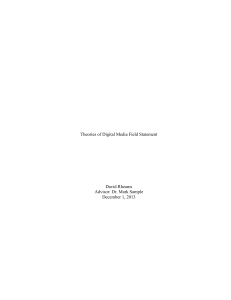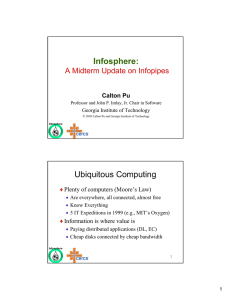Sociological impact of information technology on social Networks Abstract.
advertisement
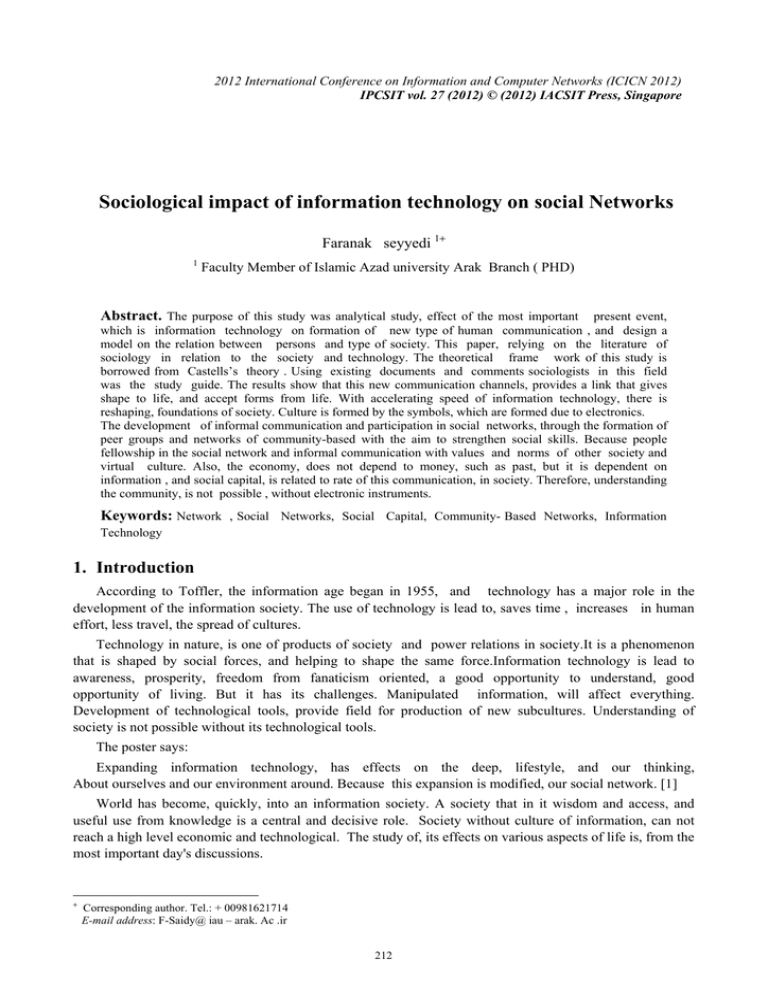
2012 International Conference on Information and Computer Networks (ICICN 2012) IPCSIT vol. 27 (2012) © (2012) IACSIT Press, Singapore Sociological impact of information technology on social Networks Faranak seyyedi 1+ 1 Faculty Member of Islamic Azad university Arak Branch ( PHD) Abstract. The purpose of this study was analytical study, effect of the most important present event, which is information technology on formation of new type of human communication , and design a model on the relation between persons and type of society. This paper, relying on the literature of sociology in relation to the society and technology. The theoretical frame work of this study is borrowed from Castells’s theory . Using existing documents and comments sociologists in this field was the study guide. The results show that this new communication channels, provides a link that gives shape to life, and accept forms from life. With accelerating speed of information technology, there is reshaping, foundations of society. Culture is formed by the symbols, which are formed due to electronics. The development of informal communication and participation in social networks, through the formation of peer groups and networks of community-based with the aim to strengthen social skills. Because people fellowship in the social network and informal communication with values and norms of other society and virtual culture. Also, the economy, does not depend to money, such as past, but it is dependent on information , and social capital, is related to rate of this communication, in society. Therefore, understanding the community, is not possible , without electronic instruments. Keywords: Network , Social Networks, Social Capital, Community- Based Networks, Information Technology 1. Introduction According to Toffler, the information age began in 1955, and technology has a major role in the development of the information society. The use of technology is lead to, saves time , increases in human effort, less travel, the spread of cultures. Technology in nature, is one of products of society and power relations in society.It is a phenomenon that is shaped by social forces, and helping to shape the same force.Information technology is lead to awareness, prosperity, freedom from fanaticism oriented, a good opportunity to understand, good opportunity of living. But it has its challenges. Manipulated information, will affect everything. Development of technological tools, provide field for production of new subcultures. Understanding of society is not possible without its technological tools. The poster says: Expanding information technology, has effects on the deep, lifestyle, and our thinking, About ourselves and our environment around. Because this expansion is modified, our social network. [1] World has become, quickly, into an information society. A society that in it wisdom and access, and useful use from knowledge is a central and decisive role. Society without culture of information, can not reach a high level economic and technological. The study of, its effects on various aspects of life is, from the most important day's discussions. + Corresponding author. Tel.: + 00981621714 E-mail address: F-Saidy@ iau – arak. Ac .ir 212 2. Network Network is composed from set of connection points, or nodes interconnected. Connection points, depending on the type of network, for example, in political network, dominant Union of Europe, connection points, are National Council of Ministers and senior European officials. Or in the global financial network, connection points are stock markets, and their ancillary service centers. [2] 3. Social Network Social networks is a social structure, which is composed of individuals or groups. Their relationship is as friendship, kinship, supportive, transaction, emotional, cognitive. This structure, perhaps, have centralized management, or without management. Each network is composed of a number of connection points or nodes (similar to nerve synapses) that the information flows among them. And control is exercised through them. Social networks are open structures, which can spread without any restriction, and be receptive, new nodes, as long as they have communication ability. In other words, as long as they have , codes common communication (eg, values, common goals).[3] 4. Kinds of social networks Emotional support network .This network is included, who have together, a very near relationship. The purpose of this network, is emotional protection, individuals in group. Social support network. This network is larger than network of emotional protection. emotional needs, not present in This network. This network of individuals, those who were called for different affairs. This affairs are variable , and maybe affairs will be very important or less important. Unified networks: This network will included, individual who recognizes them. Many people do not have specific task, except, as information carrier. Among them, can be mentioned, the network who can provide information about, employment opportunities. 5. Community - Based Networks It is a kind of social network, Which today are created with the goal community empowerment. Through it individual or community, with participation and utilization of existing resources and capacities, are possible, monitoring, evaluation and assessment measures. Which eventually, leads to change, based on insights and own capacity, or community .Today, this network used in combat, some of the social pathology. 6. Shape of Social Networks The shape of a social network helps determine a network's usefulness to its individuals. Smaller, tighter networks can be less useful to their members than networks with lots of loose connections to individuals outside the main network. More open networks, with many weak ties and social connections, are more likely to introduce new ideas and opportunities to their members than closed networks with many redundant ties. In other words, a group of friends who only do things with each other already share the same knowledge and opportunities. A group of individuals with connections to other social worlds is likely to have access to a wider range of information. It is better for individual success to have connections to a variety of networks rather than many connections within a single network. Similarly, individuals can exercise influence or act as brokers within their social networks by bridging two networks that are not directly linked (called filling structural holes).[4] Social capital in social networks, depends on the number of connections. As number of additional connections, that is greater participation, and ultimately more social capital. 7. Theoretical Aspects The first, the participants discussed social networks are scholars such as Emile Durkheim and Ferdinand Tonnies. Durkheim in the study of traditional communities, it knows based on mechanical solidarity, which is derived from collective consciousness. In industrial societies, is organic solidarity, based on human differences, and their relationships in system of social division of labor. Tonnies also, are divided, 213 their society, according to type of communication, the two gemeinschaft( personal gesellschaft (instrumental Relation ) . Relation ) and Simmel essays pointed to the nature of network size on interaction and to the likelihood of interaction in ramified, loosely-knit networks rather than groups (Simmel, 1908/1971). In 1940, A.R. Radcliffe-Brown's presidential address to British anthropologists urged the systematic study of networks. [5] Castells believed: The information revolution, which began from Silicon Valley, in California in 1970s, with unprecedented speed, created change in the infosphere of natural and cultural infosphere, and, man's spiritual infosphere . Information technology, and communication provided, possibility of the network society, which people get, in the form of fresh, new identities, and offers new definitions from human.( Castells,1385) Studies have shown that social networks have an important role in social movements (Line, 1999), employment [6] and dynamics of fashion, temporary social interests [7], forming to features individuals (Lee, 2004), the rate of disease [8] 8. Conclusion To better understand the world in which we live, it is necessary, review changes that occur. Without doubt, the creation of, social networks have been, aspect explain of activities of twenty-first century. Social networks are shown, importance of flow of information. Social networks, can be considered social impact of technology. There is exchange of thoughts, through social networks. Communications at higher levels will become the global social network. The emotional support that previously was done, through person, now, that is done, in the form of social network. Society without culture of information, can not reach into high level of economy and technology. The process of change in social networks, goes beyond from social relations and production. This process affects on culture, and power. Cultural effects, separate from local environment and geography, and ultimately, they are transmitted, via electronic communication networks. Individuals, in this networks by using communication skills, and analytical ability, which can be near their culture, and ultimately, the creation of global culture. Thus, Individuals become global citizens. Thus , In traditional societies, due to lack of technology tools, was tendency to oral conversation and in industrial society, the type of communication was by writing and speaking. But in information society, based on information technology, the type of communication is based on, virtual interaction and social networks . Economy, is not based on capital, but it is based on the information. Power tools, in traditional societies, was land, and industrial communities, was capital, but in information community, it is access to information via technology. Table 1 , The Relationship Between The Type of Society and Type of Human Relations Type of society Type of relationship Relationship level Range of communication Traditional Industrial Face to Face Writing& Face to Face Internet Micro Middle Friends ,relatives Friends ,relatives& National Universal Information Macro Dominant communication tools Speaking Writing& Speaking Chat online Dominant power tools Ground Capital Information 9. References [1] M. Poster . The Mode of Information and Postmodernity . in Crowley and Mitchell . 1994 :173-192. [2] M. Castells . Information Age: Economy, Society and Culture (strength of identity). translated Alyqlyan Ahad, 214 A. Khakbaz, H. Chavshyan , Tehran, the new plan , 1385: 544. [3] M . Castells .The Information City: Information Technology ,Economic Restructuring and the Urban – Regional Process . Oxford : Blackwell, 1989. [4] J. Scott. Social Network Analysis . London: Sage,1991 . [5] R. Brown, A.R. On Social Structure. Journal of the Royal Anthropological Institute .1940 , 70: 1–12. [6] M. Granovetter . Getting a Job : A Study in Contacts Chicago Press, 1995 . [7] and Careers. Second edition , U niversity of D. Watts. J. , Dodds , P. S. , and Newman , M. E .J. Identity and Search in Social Networks . [8] Science .2002, 296 :1035-1302. [9] Morris and Kretzchmar , M. Concurrent Partnerships and Transmission Dynamics in Networks. Social Networks . 1995 , 17 : 299-318. 215

